november 4th, 2010
Paul Ramirez Jonas
Paper Moon (I Create as I Speak), 2007
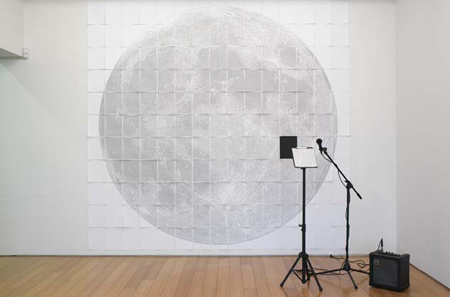
Consisting of sheets of paper tiled to represent an image of the moon, upon closer inspection, the design is made up of text that reads, “I Create as I Speak.” A single sheet is removed from the wall and rests on a lectern, with a microphone and a portable amplifier, inviting the viewer to interact with the work. The text plays with words; “I Create as I Speak” translates to ABRACADABRA in the ancient Aramaic language.
Toril Johannessen (with Vilde Salhus Røed)
Large and partly spectacular solar eclipse (08.01.08), seen from a hill between our houses, 2008
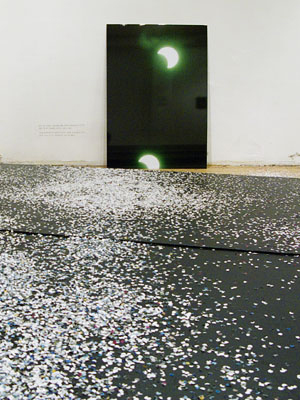

Posted in Cosmology, Etymology, Selenology, Visual Arts | Reacties uitgeschakeld voor Paper Moon
november 5th, 2008
Toine Klaassen
Untitled, 2005
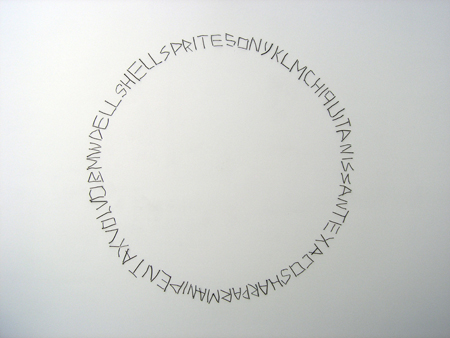
This work consists of rusty nails put on the ceiling composing the names of different global corporations like Shell, Pentax, Texaco, BMW….

Visit his TRAVELING LABORATORY FOR CONTEMPORARY ARCHAEOLOGY
——————————————————————————————————–
The 196th Law (“an eye for an eye..”) of Hammurabi, King of Babylonia, using graphics, in three different modes of cuneiform script, illustrating the evolution of signs over time. The first is the original Old Babylonian version (around 1750 BC), the second is in Neo-Assyrian signs (around 1000 BC), and the third is in the classic Sumerian signs used about 400 years before Hammurabi’s reign. Below that follow a transliteration into Akkadian and a translation into English.
Original Old-Babylonian
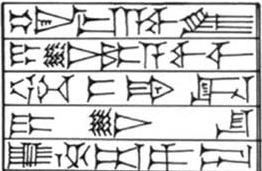
Neo-Assyrian
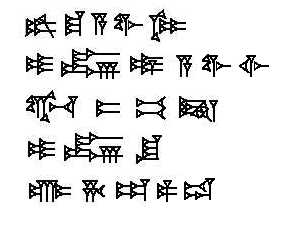
Classic Sumerian
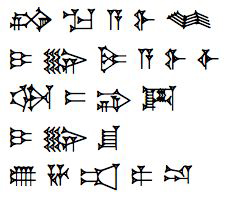
Transliteration
šumma awīlum
īn mār awīlim
uḫtappid
īn šu
uḫappadû
English
If a man
the eye of a son of man
destroys
eye his
they will destroy.
Posted in Archaeology, Etymology, Genealogy, Visual Arts | Reacties uitgeschakeld voor Contemporary Cuneiform Script
juli 25th, 2007
We Re-act
Re-adjust
Re-admit
Re-affirm
Re-afforest
Re-animate
Re-appear
Re-appoint
Re-arrange
Re-ascend
Re-assemble
Re-assert
Re-assume
Re-assure
Re-baptize
Re-bind
Re-birth
Re-bound
Re-build
Re-call
Re-capitulate
Re-capture
Re-cast
Re-cede
Re-charge
Re-claim
Re-clothe
Re-cognize
Re-coil
Re-collect
Re-commence
Re-commend
Re-compense
Re-compose
Re-condition
Re-conduct
Re-conquer
Re-consider
Re-construct
Re-count
Re-cover
Re-create
Re-criminate
Re-crudesce
Re-current
Re-deem
Re-descend
Re-develop
Re-distribute
Re-double
Re-draft
Re-draw
Re-dress
Re-duplicate
Re-echo
Re-edify
Re-elect
Re-eligible
Re-embark
Re-enact
Re-enter
Re-establish
Re-examine
Re-export
Re-fashion
Re-fill
Re-fine
Re-fit
Re-float
Re-form
Re-fresh
Re-fuel
Re-fund
Re-furbish
Re-generate
Re-group
Re-habilitate
Re-house
Re-import
Re-incarnate
Re-inforce
Re-insert
Re-instate
Re-insure
Re-introduce
Re-invent
Re-invest
Re-issue
Re-iterate
Re-join
Re-juvenate
Re-kindle
Re-lapse
Re-lax
Re-lay
Re-lease
Re-legate
Re-light
Re-live
Re-make
Re-mark
Re-marry
Re-member
Re-mind
Re-miss
Re-model
Re-mould
Re-move
Re-name
Re-nascence
Re-new
Re-occupy
Re-open
Re-organize
Re-pass
Re-pay
Re-peal
Re-people
Re-percussion
Re-petition
Re-place
Re-plant
Re-plenish
Re-polish
Re-populate
Re-pose
Re-possess
Re-pot
Re-present
Re-press
Re-print
Re-produce
Re-prove
Re-publish
Re-pulse
Re-purchase
Re-sale
Re-search
Re-seat
Re-seize
Re-sell
Re-serve
Re-set
Re-settle
Re-ship
Re-shuffle
Re-sign
Re-solution
Re-solve
Re-sort
Re-sound
Re-source
Re-strain
Re-strict
Re-surgent
Re-surrect
Re-survey
Re-tell
Re-tire
Re-touch
Re-trace
Re-tract
Re-treat
Re-turn
Re-unite
Re-use
Re-value
Re-vision
Re-view
Re-vote
Re-wind
Re-write
Posted in Etymology, Ontology, Universal | Reacties uitgeschakeld voor The RE- generation
april 13th, 2007

A representation of the internet
(Credit: Bill Cheswick, Lumeta Corp.)
In both computer science and information science, an ontology is a data model that represents a domain and is used to reason about the objects in that domain and the relations between them. Ontologies are used in artificial intelligence, the semantic web, software engineering and information architecture as a form of knowledge representation about the world or some part of it.
The term ontology has its origin in philosophy, where it is the name of a fundamental branch of metaphysics concerned with existence. According to Tom Gruber at Stanford University, the meaning of ontology in the context of computer science, however, is “a description of the concepts and relationships that can exist for an agent or a community of agents.” He goes on to specify that an ontology is generally written, “as a set of definitions of formal vocabulary.”

Swoogle is a search engine for the Semantic Web on the Web. Swoogle crawl the World Wide Web for a special class of web documents called Semantic Web documents, which are written in RDF (Resource Description Framework). Swoogle is a research project being carried out by the ebiquity research group in the Computer Science and Electrical Engineering Department at the University of Maryland, Baltimore County (UMBC).
Posted in Etymology, Ontology | 1 Comment »
maart 14th, 2007
Vilém Flusser
… ‘Writing is an important gesture, because it both articulates and produces that state of mind which is called “historical consciousness.” History began with the invention of writing, not for the banal reason often advanced that written texts permit us to reconstruct the past, but for the more pertinent reason that the world is not perceived as a process, “historically,” unless one signifies it by successive symbols, by writing. The difference between prehistory an history is not that we have written documents that permit us to read the latter, but that during history there are literate men who experience, understand, and evaluate the world as “becomming,” whereas in prehistory no such existential attitude is possible. If the art of writing were to fall into oblivion, or if it were to become subservient to picture making (as in the “scriptwriting” in films), history in the strict sense of that term would be over.’
‘If one examines certain Mesopotamian tiles, one can see that the original purpose of writing was to facilitate the deciphering of images. Those tiles contain images impressed upon them with cylindrical seals and “cuneiform” symbols scratched into them with a stylus. The “cuneiform” symbols form lines, and they obviously mean the image they accompany. They “explain;” “recount;” “tell” it. They do so by unrolling the surface of the image into lines, by unwinding the tissue of the image into the threads of a text, by rendering “explicit” what was “implicit” within the image. It may be shown through text analysis that the original purpose of writing, namely, the transcoding of two-dimensional codes into a single dimension, is still there: every text, even a very abstract one, means, in the last analysis, an image.’ …
Posted in Etymology, Philology, Philosophy | Reacties uitgeschakeld voor The Future of Writing









